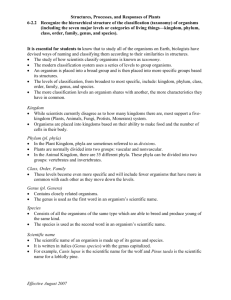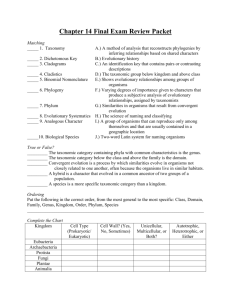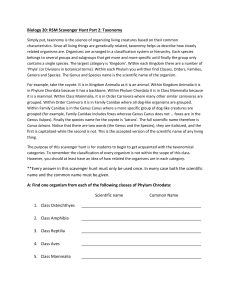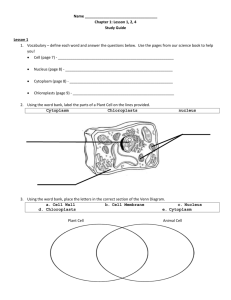DO NOT WRITE ON THE EXAM Test: changes over time (100 points
advertisement
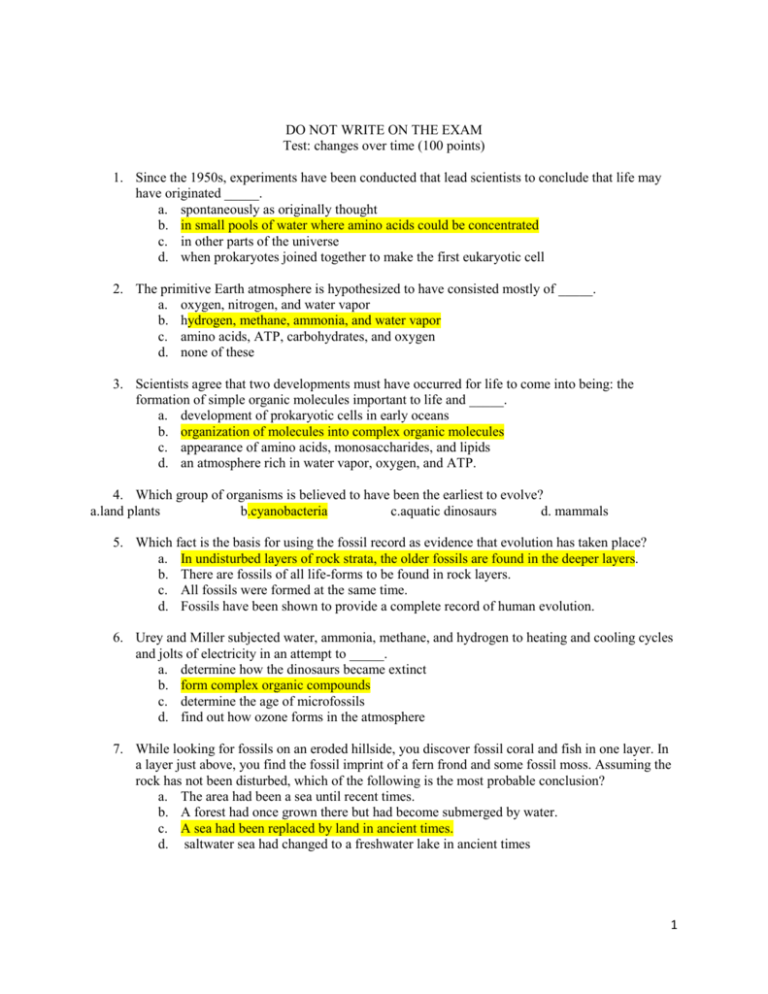
DO NOT WRITE ON THE EXAM Test: changes over time (100 points) 1. Since the 1950s, experiments have been conducted that lead scientists to conclude that life may have originated _____. a. spontaneously as originally thought b. in small pools of water where amino acids could be concentrated c. in other parts of the universe d. when prokaryotes joined together to make the first eukaryotic cell 2. The primitive Earth atmosphere is hypothesized to have consisted mostly of _____. a. oxygen, nitrogen, and water vapor b. hydrogen, methane, ammonia, and water vapor c. amino acids, ATP, carbohydrates, and oxygen d. none of these 3. Scientists agree that two developments must have occurred for life to come into being: the formation of simple organic molecules important to life and _____. a. development of prokaryotic cells in early oceans b. organization of molecules into complex organic molecules c. appearance of amino acids, monosaccharides, and lipids d. an atmosphere rich in water vapor, oxygen, and ATP. 4. Which group of organisms is believed to have been the earliest to evolve? a.land plants b.cyanobacteria c.aquatic dinosaurs d. mammals 5. Which fact is the basis for using the fossil record as evidence that evolution has taken place? a. In undisturbed layers of rock strata, the older fossils are found in the deeper layers. b. There are fossils of all life-forms to be found in rock layers. c. All fossils were formed at the same time. d. Fossils have been shown to provide a complete record of human evolution. 6. Urey and Miller subjected water, ammonia, methane, and hydrogen to heating and cooling cycles and jolts of electricity in an attempt to _____. a. determine how the dinosaurs became extinct b. form complex organic compounds c. determine the age of microfossils d. find out how ozone forms in the atmosphere 7. While looking for fossils on an eroded hillside, you discover fossil coral and fish in one layer. In a layer just above, you find the fossil imprint of a fern frond and some fossil moss. Assuming the rock has not been disturbed, which of the following is the most probable conclusion? a. The area had been a sea until recent times. b. A forest had once grown there but had become submerged by water. c. A sea had been replaced by land in ancient times. d. saltwater sea had changed to a freshwater lake in ancient times 1 8. Which event contributed most directly to the evidence of aerobic organisms? a. an increase in the concentration of methane in the ancient atmosphere b. a decrease in the sun's light intensity c. the presence of organisms able to carry on photosynthesis d. an increase in the number of organisms carrying on fermentation 9. The flying squirrel of North America closely resembles the flying phalanger of Australia. They are similar in size and have long, bushy tails and skin folds that allow them to glide through the air. The squirrel is a placental mammal, while the phalanger is a marsupial. These close resemblances, even though genetically and geographically separated by great distances, can best be explained by _____. a.convergent evolution b.divergent evolution c.spontaneous generation d.vestigial structures 10. Hawaiian honeycreepers are a group of birds with similar body shape and size. However, they vary greatly in color and beak shape. Each species occupies its own niche and is adapted to the foods available in its niche. The evolution from a common ancestor to a variety of species is an example of _____. a.divergent evolution b.cross-pollination c.vegetative propagation d.convergent evolution 11. Within a decade of the introduction of a new insecticide, nearly all of the descendants of the target pests were immune to the usual-sized dose. The most likely explanation for this immunity to the insecticide is that _____. a. eating the insecticide caused the bugs to become resistant to it b. eating the insecticide caused the bugs to become less resistant to it c. it destroyed organisms that cause disease in the insects, thus allowing them to live longer d. the pests developed physiological adaptations to the insecticide 12. Natural processes such as speciation and gradualism provide the genetic basis for _____. a.evolution b.spontaneous generation c.biogenesis d.sexual reproduction 13. Structures that have a similar evolutionary origin and structure but are adapted for different purposes, such as a bat wing and a human arm, are called _____. a. embryological structures c. homologous structures b. analogous structures d. homozygous structures 14. Natural selection can best be defined as the _____. a. survival of the biggest and strongest organisms in a population b. elimination of the smallest organisms by the biggest organisms c. survival and reproduction of the organisms that occupy the largest area d. survival and reproduction of the organisms that are genetically best adapted to the environment 15. A pattern of evolution that results when two unrelated species begin to appear similar because of environmental conditions is _____. a.disruptive selection b.convergent evolution c.directional selection c. random selection 16. The average individuals of a population are favored in _____ selection. a. directional b. stabilizing c.disruptive d.natural 2 17. In _____ selection, individuals with both extreme forms of a trait are at a selective advantage. a. directional b. stabilizing c. disruptive d. natural 18. _____ selection favors one extreme form of a trait in a population. a. directional b. stabilizing c. disruptive d. natural 19. What is the movement of genes into and out of a gene pool called? a.random mating b.nonrandom mating c.gene flow d.direct evolution 20. The founder of modern evolution theory is considered to be _____. a.Charles Darwin b.Alexander Oparin c.Stephen Jay Gould d.Lynn Margulis 21. Upon close examination of the skeleton of an adult python, a pelvic girdle and leg bones can be observed. These features are an example of _____. a. artificial selection c. vestigial structures b. homologous structures d. comparative embryology 22. Which of the following is not a factor that causes changes in the allelic frequencies of individuals in a population? a. stabilizing selection c. random selection b. directional selection d. disruptive selection 23. The structures shown in Figure 15-5 are _____. i. Figure 15-5 a. homologous b. heterologous c. analogous d. vestigial 24. A heterotrophic eukaryote associated with the decomposition of dead organisms is a(n) _____. a.bacterium b.herbivore c.fungus d.protist 25. The evolution of an ancestral species into an array of species that occupy diverse habitats is called a. genetic drift b. speciation c. genetic equilibrium d. adaptive radiation 26. Any structure that is reduced in function in a living organism but may have been used in an ancestor is known as a(n) a. vestigial structure b. homologous structure c. analogous structure d. Artificial structure 27. ____________________ is a mechanism for change in a population in which organisms with favorable variations live, reproduce, and pass on their favorable traits. a. directional selection b. adaptive radiation c. natural selection d. speciation 3 28. Any species with a multiple set of chromosomes is known as a(n) ____________________. a. genetic drift b. polyploidy c. vestigial structure d. gradualism 29. The ____________________ is the percentage of a particular allele in a population. a. polyploidy b. allelic frequency c. natural selection d. gene pool Match each item with the correct statement below. a. phylum e. family b. order ab. species c. genus ac. class d. kingdom 30. 31. 32. 33. 34. 35. 36. group of related families group of related classes group of related species group of related genera smallest taxonomic group group of related orders group of related phyla b a c e ab ac d 37. Which of the following is the correct taxonomic order? a. phylum, kingdom, order, class, family, genus, species b. kingdom, phylum, class, order, family, genus, species c. kingdom, phylum, order, family, class, species, genus d. phylum, order, kingdom, class, family, species, genus Match each item with the correct statement below a. eubacteria b. archaebacteria c. protists 38. 39. 40. 41. 42. d. fungi e. plants ab. Animals kingdom of eukaryotic decomposers kingdom of eukaryotes that lack complex organ systems kingdom of multicellular eukaryotic consumers kingdom of prokaryotes that live in extreme conditions kingdom of photosynthesizing eukaryotes d c ab b e 4 Name:_________________________________ date:____________ block:___________ RECORD ANSWERS DIRECTLY ON THIS SHEET: 5 Short answer: (3 points) If archeologists found the remains of a dinosaur and a human in the same layer of rock could he conclude that they lived at the same time? Explain. Bonus: (5 points) Suppose you are examining layers of sedimentary rock. In one layer, you discover the remains of an extinct relative of the polar bear. In a deeper layer, you discover the fossil of an extinct alligator. What can you hypothesize about changes over time in this area’s environment? 6



